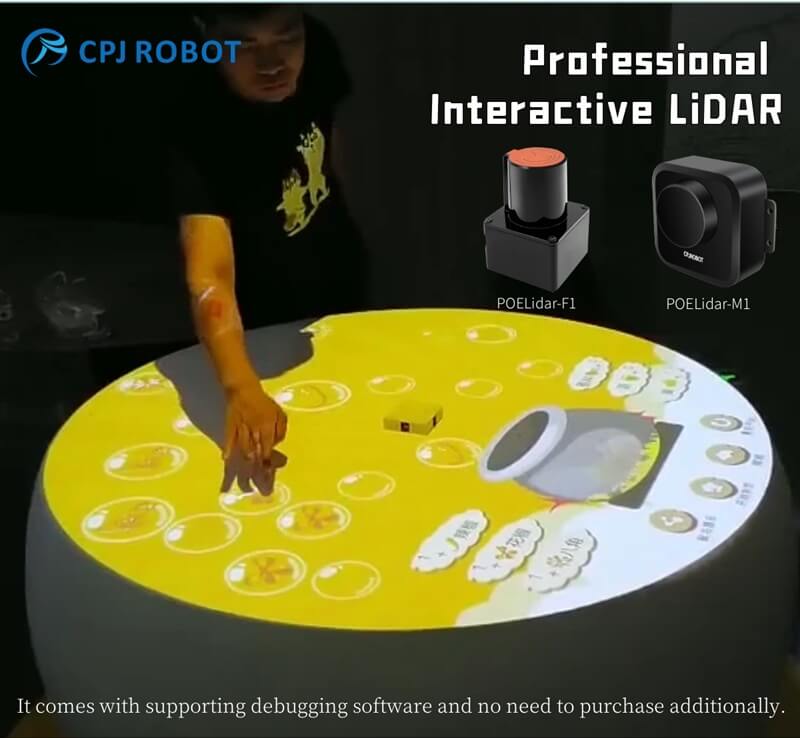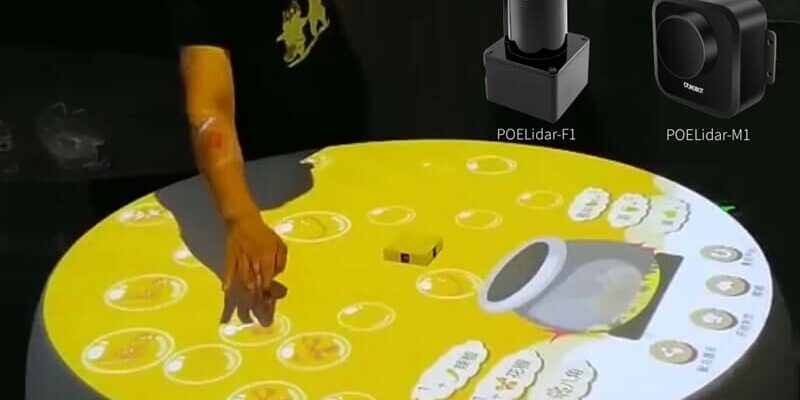Introduction
In today’s era of immersive digital interaction, LiDAR interactive projection is transforming how users engage with content. Unlike traditional touchscreens, these systems allow users to interact via touchless multi-point gestures, offering more natural and hygienic control. But how exactly does this technology work?
This article explains the core principles and implementation of LiDAR-based non-contact interaction systems, including signal emission, real-time data processing, and multi-touch gesture recognition.

- Emitting and Detecting LiDAR Signals
LiDAR sensing devices—installed above or alongside the projection area (wall, floor, or tabletop)—emit invisible light pulses that cover the interaction space.
When a user’s hand or body enters the sensing layer, it reflects or disrupts these LiDAR signals. The sensors detect these changes in real time and transmit the data to the main system for further analysis.
- Real-Time Signal Processing
Once the altered LiDAR signals are received:
Analog signals are converted to digital using high-speed A/D converters.
FPGA and DSP processors analyze the data in real time.
Position and motion are determined using distance, angle, and point cloud modeling.
With AI-driven algorithms, the system recognizes complex gestures and supports multi-point interaction.
This ensures highly accurate, low-latency gesture detection—even in dynamic or crowded environments.
- True Touchless Multi-Point Interaction
LiDAR interactive projection creates a virtual touch layer in the air, offering the following advantages:
Users can click, drag, and swipe without any physical contact.
Multiple users can interact simultaneously from different angles.
Works stably under strong light or outdoor conditions, thanks to LiDAR’s excellent anti-interference capabilities.
Supports non-flat surfaces, such as curved walls, glass, or water—making it ideal for creative applications.
- System Architecture and Visual Feedback
The complete setup typically includes:
A POE-powered LiDAR sensor,
A computer host running the interaction software,
A projector or display for visual output.
The LiDAR detects user movements and sends precise location data to the host, which drives visual feedback in real time—enabling seamless human-machine interaction.
Conclusion
LiDAR interactive projection systems offer a cutting-edge, contactless alternative to traditional touch technology. With fast, accurate, and flexible gesture recognition, they’re ideal for:
Museums and science centers
Smart classrooms
Retail and brand experiences
Gaming and entertainment spaces
Whether it’s for education, entertainment, or engagement, this technology provides a natural, intuitive, and highly scalable interactive solution.
About CPJROBOT
CPJROBOT is a leading developer and manufacturer specializing in POE LiDAR and reception service robots. Our LiDAR interactive systems are trusted in exhibitions, digital signage, and smart environments around the world.
✅ Free calibration software
✅ 100+ ready-to-use interactive games
✅ Custom solutions for your space
? Ready to upgrade your space with contactless interaction?
Get in touch with CPJROBOT today and bring your walls, floors, or tables to life!







